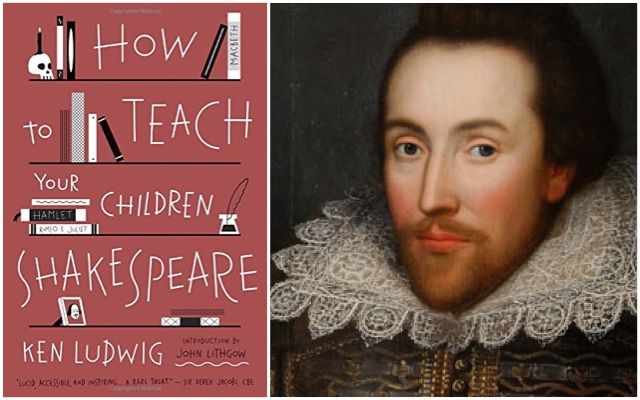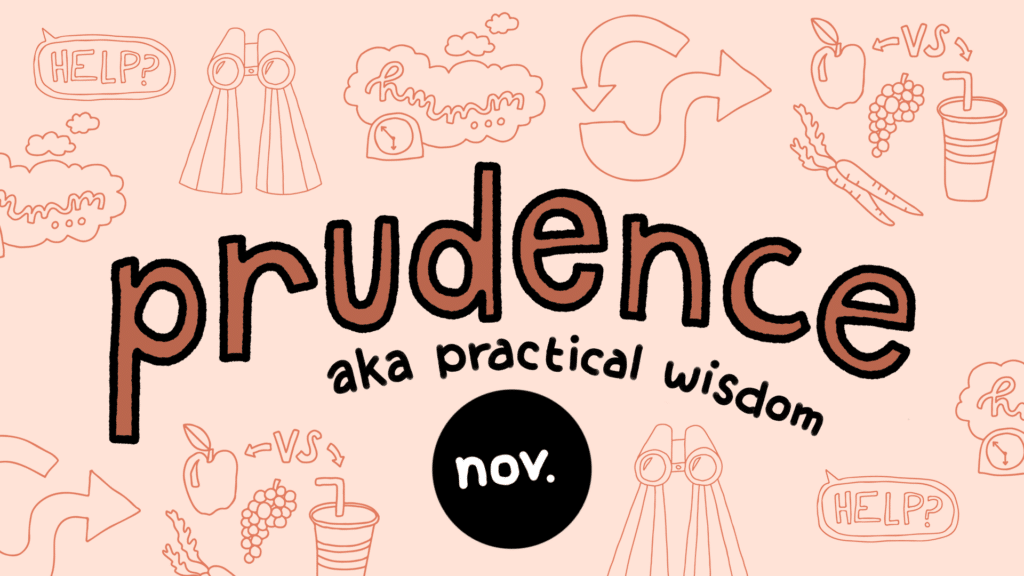
{image credit: amazon.com, theguardian.com}
Perhaps you’ve seen this book in our school store. If you’ve been curious about it, today Jenna Burns is going to shed some light on this wonderful resource!
Pedagogic Ponderings
Mrs. Burns’ Book Review Blog
Pedagogic Ponderings is a blog review of pedagogic (educational) books by our own Jenna Burns. After teaching History and Language Arts at SLOCA UMS for five years, Jenna is taking this year off of teaching to care for her new daughter, Julianna. But she is not taking a break from learning! She is seeking out the best books on education, reading them, pondering them, and reviewing them for us. In her blog she gives us a snapshot of the books and how their educational philosophies connect to what we are doing at SLOCA. We hope her blog helps you better understand classical education and our school.

This month I’m reviewing How to Teach Your Children Shakespeare by Ken Ludwig. I chose this book to review because we will be reading Hamlet in the spring, which is a daunting endeavor even for the bravest among us. I found the practical advice on how to teach Hamlet in this book, and I can’t wait to share it with you! So, read this month’s blog to learn Mrs. Burns’ favorite sonnet, hear how to teach Shakespeare at home, and get some great tips on how to make memorization a game.
The experience of reading Shakespeare reminds me of looking into one of the Magic Eye 3D posters that were so popular in the 90’s, like this one:

{image credit: magiceye.com}
Apparently, the hidden image within this picture is two boys sledding (I still don’t see it).
Why were these illusions such a craze? I think it is because people become excited when the nonsensical smattering of blobs shift, and the hidden image bursts into focus. We now see the secret, and we have boasting rights.
I read Hamlet in my junior AP Literature class, and I found it utterly incomprehensible. I fancied myself a rather sophisticated critic, as I determined my teacher had completely overrated Shakespeare’s genius. Clearly, if he couldn’t even write a sentence I could understand, he must not be all that great.
But then there was that moment when Shakespeare’s nonsensical language burst into focus. It was while reading Sonnet 116 and the words, “Love is not love which alters when it alteration finds,” made my teenage heart swoon. It was thrilling.
Ken Ludwig, in his wholly enjoyable book, How to Teach Your Children Shakespeare, makes the aha! moment accessible to you and your child. You will memorize, for example, Cesario’s words to Olivia in Twelfth Night: “Halloo your name to the reverberate hills.” If you are like me, this line won’t seem special to you at first, but by the end of Ludwig’s explication you will be agreeing with his statement that Cesario’s words, “makes my heart skip a beat” (71). You will learn what O, Romeo, Romeo, wherefore art thou Romeo? actually means (it is not what you think!). But most importantly you will learn a practically painless and FUN way to teach your children Shakespeare.
I love Ludwig’s passion and his pedagogic approach. As you read his book you and your child will memorize twenty-five passages from nine different plays. Along the way you will hear all about the plays’ plots and characters, as well as learn facts about Shakespeare’s personal life, writing style, career, etc.
Another wonderful thing about this book is the online resource:
http://www.howtoteachyourchildrenshakespeare.com
There you will find quotation sheets that break “every passage up into short, logical chunks based on rhythm and meaning” and present them in “large, attractive fonts,” (15). Here is a portion of a quotation sheet taken from the website:

These quotation sheets assist the memorization process immensely. The website also features audio clips of actors reciting each passage – a big help when it comes to pronunciation and expression!
There is so much to love about this book, but here are my three take-aways:
1. Teaching your children Shakespeare is all about memorization. Shakespeare’s plays are difficult to read as unfamiliar words, odd sentence structure, and colorful metaphors abound. Ludwig explains: “Shakespeare is like a foreign language. In order to learn it, we need to understand every word, then practice until we feel comfortable. If your children memorize one line at a time, then a short speech, then a longer speech, they’ll become self-assured and then fluent. At that point, Shakespeare will become part of their literary vocabulary,” (10). It’s true. It will become part of their vocabulary. Just yesterday, as I read my daughter a picture book, I pointed to the page and said, “There is the sun, Julianna, in his flame-colored taffeta.” That metaphor from Henry IV Part I just popped right out of my mouth! Your children, too, will have Shakespeare’s “lines at their fingertips and [will] spout them whenever the occasion present[s] itself,” (12).
2. Teaching your children Shakespeare is all about spending quality time with them.
Ludwig makes this memorization process a fun family experience. In a special chair with a pillow on his head for a crown and holding a dagger as if it were a scepter, your son will be reciting Falstaff’s words: “This chair shall be my state [throne], this dagger my scepter, and this cushion my crown,” (170). When learning about Twelfth Night your daughter’s bed will become a “ship [that] hits a rock, and now your daughter tumbles from her bed and across the floor. She’s on a beach, and for a moment she’s unconscious [. . .] She catches her breath and says: What country, friends, is this?” (85). Pillows on heads and tumbling from beds! Could learning Shakespeare together as a family be any more fun then this? I see a huge potential here for some great home videos, adorable pictures, and lasting memories.
3. Teaching your children Shakespeare is all about discussing the realities of life.
I want to believe if I shelter my daughter from Hamlet she will never hear about such horrible things as murder and suicide. Unfortunately, this isn’t true. Shakespeare has stayed relevant, speaking powerfully across centuries because of his ability to explore the best, worst, and everyday emotions of the human condition. Ludwig remarks on the value of learning Shakespeare with, “Shakespeare is, indisputably, one of the two great bedrocks of Western civilization in English. (The other is the King James translation of the Bible.) Not only do Shakespeare’s plays themselves
contain the finest writing of the past 450 years, but most of the best novels, plays, poetry, and films in the English language produced since Shakespeare’s death in 1616 – from Jane Austen to Charles Dickens, from Ulysses to The Godfather – are heavily influenced by Shakespeare’s stories, characters, language, and themes,” (7).
As you can already see by now, Ludwig’s book fits right into what we are doing at SLOCA. His focus on recitation and quality literature is core to our classical education approach. His information on Shakespeare and Hamlet will make for a great resource as we dive into this play in the spring. Though his book is specific to Shakespeare, his process of using memorization to master difficult literature could be applied to any classic. With that in mind, let me leave you with one last great pearl of wisdom from Ludwig to help you in your homeschooling efforts: “Remember, always, always, make the memorization a game for your children. Chest tones, patty-cake, marching, shouting, acting, wearing hats and cloaks, contests, bets, painting on mustaches, bribery by chocolate, whatever it takes. My view was always a ruthless one: Anything I could do to help them memorize the passage was fair game,” (72).
Coming up next: Climbing Parnassus: A New Apologia for Greek and Latin by Tracy Lee Simons
I chose this book to read next so I could better understand the reason for teaching our students Latin. Stay tuned!

We are definitely excited to dive into Shakespeare next trimester, and hope you are too! Whether you’re feeling intimidated by the thought of learning Shakespeare with your kids, or ready to take it on, this book is sure to boost your confidence and your family’s appreciation of the bard. Thank you, Jenna!
If you have any thoughts to share about How to Teach Your Children Shakespeare or anything else Shakespeare, please leave a comment below!
Other reviews in this series:
The Read-Aloud Handbook by Jim Trelease
Ten Ways to Destroy the Imagination of your Child by Anthony Esolen
The Well-Trained Mind by Susan Wise Bauer and Jesse Wise
The Core by Leigh A. Bortins
Climbing Parnassus by Tracy Lee Simmons
Last Child in the Woods: Saving our Children from Nature-Deficit Disorder by Richard Louv
Play: How it Shapes the Brian, Opens the Imagination, and Invigorates the Soul by Dr. Stuart Brown
SLO Classical Academy is not affiliated with any of the above mentioned websites or businesses.











